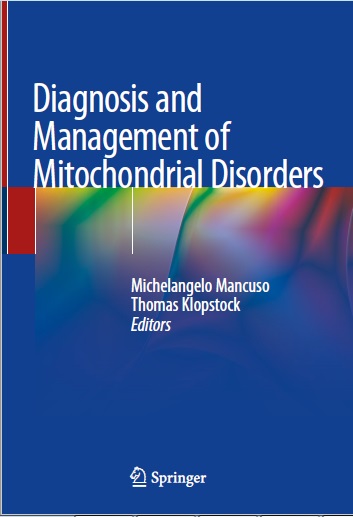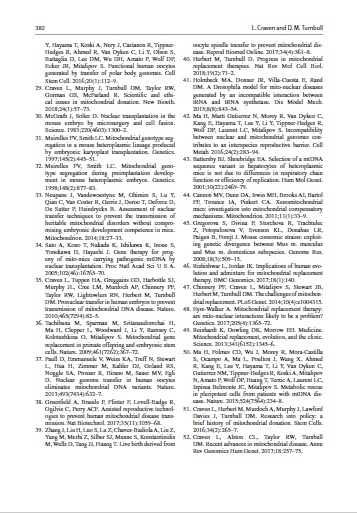

Diagnosis and Management of Mitochondrial Disorders
By
Pishronovin
Mitochondrial Medicine:
A Historical Point of View
Yi Shiau Ng, Salvatore DiMauro,
and Doug M. Turnbull
Introduction
Mitochondria are essential double-membrane,
dynamic organelles found in all nucleated cells,
and they are referred as the powerhouse in cells
because of their vital role in generating ATP via the
oxidative phosphorylation (OXPHOS). The
OXPHOS machinery is located at the inner mitochondrial
membrane and comprises five enzymatic
complexes, which are mitochondrial respiratory
chain (complexes I to IV) and ATP synthase (complex
V). The mechanism by which the passage of
electrons down the respiratory chain generates ATP
was described by Peter Mitchell [1], who was
awarded the Nobel Prize for Chemistry in 1978.
Mitochondria are also important players in multiple
other cellular activities such as intrinsic apoptosis,
redox, calcium handling and urea cycle.
One of the most fascinating biological features
of mitochondria is that they contain extranuclear
DNA materials, mitochondrial DNAs (mtDNA),
which are tiny, double-stranded DNA molecules
that exist in multiple copies per cell and only encode
37 genes. However, the replication and maintenance
of mtDNA and almost all building blocks of mitochondria
are controlled by the nuclear genome. The
cross talk between the mitochondrial DNA and
nucleus means that any genetic defects in either
mtDNA or nuclear genome could perturb the mitochondrial
functions especially the OXPHOS, consequently
leading to the development of disease.
The clinical features of mitochondrial disease
are very variable with high-energy demand tissues
and organs such as the brain, skeletal muscle, heart,
liver and optic nerves, which are particularly susceptible
to the mitochondrial dysfunction. However,
mitochondrial disease can affect practically any
organ making the diagnosis and management challenging.
Mitochondrial diseases are one of the most
common groups of inherited neurogenetic disorders
with a minimal prevalence of 1 in 4300 [2],
comparably, if not, higher than other common neurogenetic
disorders such as Charcot-Marie-Tooth
neuropathy and myotonic dystrophy [3].
In this chapter, we begin with an overview of
the pathological description of various mitochondrial
syndromes, the biochemical classification of
mitochondrial defects, followed by the era of identification
of primary mtDNA mutations and discoveries
of multiple nuclear genes implicated in
mitochondrial disease. We also highlight the emergence
of reproductive options especially mitochondrial
donation in primary mtDNA disease and
advancement in potential treatments (Fig. 1).
Y. S. Ng · D. M. Turnbull (*)
Wellcome Centre for Mitochondrial Research,
Institute of Neuroscience, Newcastle University,
Framlington Place, Newcastle Upon Tyne, UK
e-mail: doug.turnbull@ncl.ac.uk
S. DiMauro
Houston Merritt Clinical Research Center,
Columbia University, New York, NY, USA
Department of Neurology, College of Physicians
and Surgeons, New York, NY, USA
A Historical Point of View
Yi Shiau Ng, Salvatore DiMauro,
and Doug M. Turnbull
Introduction
Mitochondria are essential double-membrane,
dynamic organelles found in all nucleated cells,
and they are referred as the powerhouse in cells
because of their vital role in generating ATP via the
oxidative phosphorylation (OXPHOS). The
OXPHOS machinery is located at the inner mitochondrial
membrane and comprises five enzymatic
complexes, which are mitochondrial respiratory
chain (complexes I to IV) and ATP synthase (complex
V). The mechanism by which the passage of
electrons down the respiratory chain generates ATP
was described by Peter Mitchell [1], who was
awarded the Nobel Prize for Chemistry in 1978.
Mitochondria are also important players in multiple
other cellular activities such as intrinsic apoptosis,
redox, calcium handling and urea cycle.
One of the most fascinating biological features
of mitochondria is that they contain extranuclear
DNA materials, mitochondrial DNAs (mtDNA),
which are tiny, double-stranded DNA molecules
that exist in multiple copies per cell and only encode
37 genes. However, the replication and maintenance
of mtDNA and almost all building blocks of mitochondria
are controlled by the nuclear genome. The
cross talk between the mitochondrial DNA and
nucleus means that any genetic defects in either
mtDNA or nuclear genome could perturb the mitochondrial
functions especially the OXPHOS, consequently
leading to the development of disease.
The clinical features of mitochondrial disease
are very variable with high-energy demand tissues
and organs such as the brain, skeletal muscle, heart,
liver and optic nerves, which are particularly susceptible
to the mitochondrial dysfunction. However,
mitochondrial disease can affect practically any
organ making the diagnosis and management challenging.
Mitochondrial diseases are one of the most
common groups of inherited neurogenetic disorders
with a minimal prevalence of 1 in 4300 [2],
comparably, if not, higher than other common neurogenetic
disorders such as Charcot-Marie-Tooth
neuropathy and myotonic dystrophy [3].
In this chapter, we begin with an overview of
the pathological description of various mitochondrial
syndromes, the biochemical classification of
mitochondrial defects, followed by the era of identification
of primary mtDNA mutations and discoveries
of multiple nuclear genes implicated in
mitochondrial disease. We also highlight the emergence
of reproductive options especially mitochondrial
donation in primary mtDNA disease and
advancement in potential treatments (Fig. 1).
Y. S. Ng · D. M. Turnbull (*)
Wellcome Centre for Mitochondrial Research,
Institute of Neuroscience, Newcastle University,
Framlington Place, Newcastle Upon Tyne, UK
e-mail: doug.turnbull@ncl.ac.uk
S. DiMauro
Houston Merritt Clinical Research Center,
Columbia University, New York, NY, USA
Department of Neurology, College of Physicians
and Surgeons, New York, NY, USA

